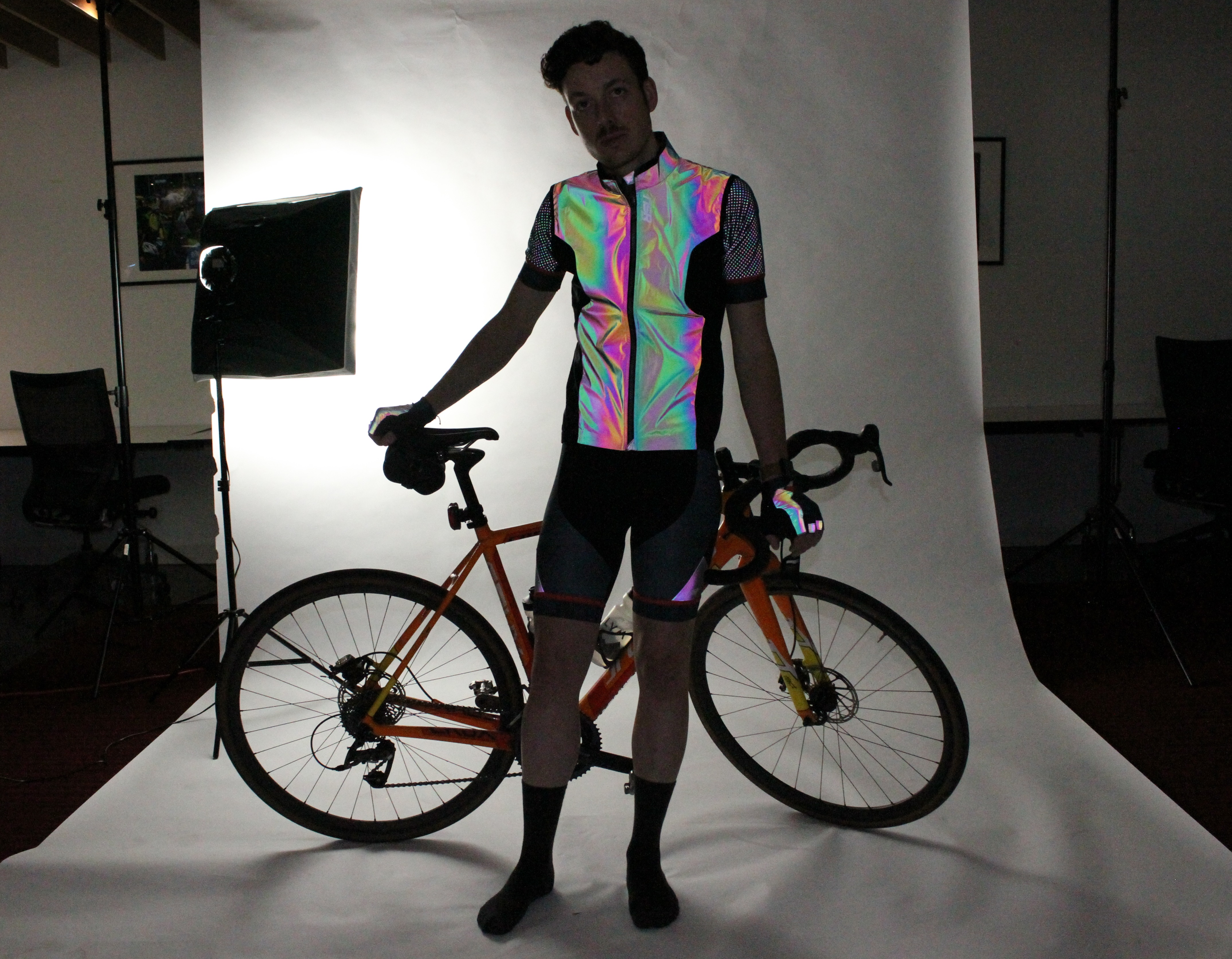Iain Treloar tests a visibility-oriented kit from a newcomer to the Australian market.
The Korean brand NSR Riding have been in existence since 2010, but are new to the Australian market. They’re the cycling offshoot of a major textile manufacturing group that produces the apparel of internationally recognised brands including le coq sportif, New Balance, Alpinestar and Dainese, among many others. With a diverse cycling range encompassing everything from entry-level all the way up to the top-end, across both genders, NSR have considerable depth to their offering. However, with greater experience in technical apparel outside of the cycling space, what remained to be seen was whether their chops as manufacturers translated to on-bike performance.
We were sent a selection of gear from the Flash range to review. This particular collection has a road-riding slant, with a primary focus on visibility. As such, reflective elements are widely used throughout the range. It’s an uncommon but refreshing move in an industry that usually favours either a stealthy appearance or fluorescent lairiness.
With studies showing that reflective clothing far outperforms fluorescent clothing as a night-time visibility aid (2010, Journal of the Australian College of Road Safety) it’s gratifying to see the extent to which NSR have taken things here. Whilst reflective elements are most effective on moving body parts directly in a motorist’s line of sight (especially feet and knees), the Flash collection is nonetheless likely to be a considerable improvement visibility-wise over the majority of other kit on the market.
Asian clothing brands often run small, but as NSR is producing products for both its home region and abroad, all clothing is labelled with two sizes – Asian and US/European sizing. The products I tested were therefore designated as Asian Medium / US/European Small. The sizing charts on the website are a little inexact – based on my experiences, I’d suggest sizing down one from your usual if you’re of a similar physique to me.
Flash Spectrum Gilet
Price: ~$145AUD
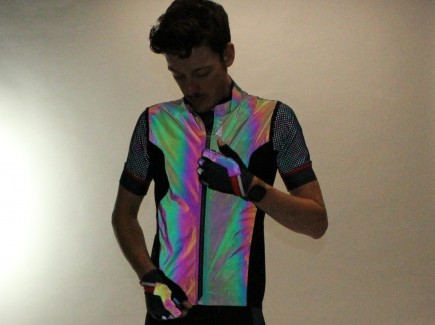
The marquee product of the Flash range is the gilet, constructed almost entirely of reflective materials. Adding versatility are a pair of zipped pockets at the rear. It’s a solidly constructed garment, with a sturdy metal zipper at the front, and made of a thick fabric that proves highly effective as a windstopper. However, because of its heft I’d have concerns about it becoming too warm in some conditions; I run fairly warm on the bike but even so I was surprised to find myself overheating when the temperature was in the high single-digits.
I’m a big fan of gilets with pockets, finding that they make a positive difference to functionality. That holds true here, too, but their integration on the Flash Gilet could have been cleaner. The pockets were quite narrow and deep, making removal of smaller items a challenge. Further, the zipped closure was narrower than the pocket itself, so wider items (phones, for instance) had a habit of getting snagged on the way out. Personally, I also prefer a three-pocket configuration rather than the two here, just to balance loads better.
The reflective fabric of the vest has a curious glow to it. It’s quite mesmerising, with a dull rainbow shimmer like fish scales. As pretty as it is, it’s less effective than the bright white glowing Scotchlite material more commonly used in reflective apparel.
The Spectrum Gilet is durable and tough-wearing but for my money a lighter-weight fabric would make more sense for packability and Australian conditions (Korea is considerably colder than here). And whilst its visibility is very good compared to most other standard vests, it’s not class-leading for a reflective vest – for comparison to a competitor’s Scotchlite vest, see below:
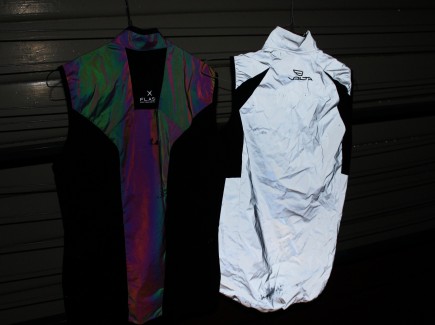
Flash Spectrum Jersey
Price: ~$145AUD
The Flash jersey features an interesting assortment of ritzy fabrics which seem destined to combine into a high-performing garment. Reflective duties are taken care of by a band of reflective material – the same as that on the vest – across the base of the rear pockets, and a closely-placed pattern of small reflective dots circling the upper half of the torso and running down the sleeves.
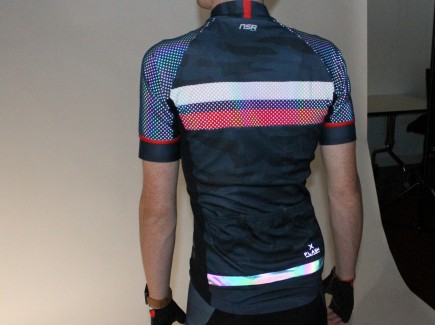
Excellent grippers are used at the arm, with a similar finish to best-in-industry gripper offerings from brands like Cuore. On my admittedly skinny arms, unfortunately, there wasn’t a snug enough fit for the grippers to grip to prove most effective. A similar treatment was used at the rear base of the jersey. I’ve not seen this material used there before but it makes great sense, preventing the upward creep of the jersey when riding.
Pocket volume isn’t enormous, and the bulkiness of the gilet highlights this issue – it’s a companion garment that doesn’t fold up small enough to fit in the jersey.
The cut of the jersey is mostly well-proportioned, but a little longer than you’d expect for a race-fit. As a result, there was some bunching of the fabric when hunched over to the handlebars. Nonetheless, the jersey was a promising demonstration of the material expertise and resources at NSR’s disposal, and works well as a standalone item.
Flash Spectrum Bib Shorts
Price: ~$170AUD
Bib shorts are not an easy garment to perfect – they’re the most comfort-critical item of the cycling wardrobe, the closest fitting and the most technical. They’re also the most personal, and what works for the particular combination of riding position/saddle choice/personal physiology of one rider may not for another.
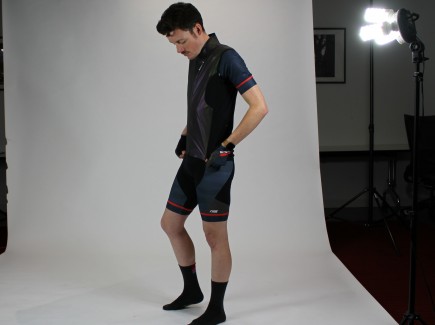
So whilst I didn’t personally get along with the Flash Spectrum Bib Shorts, that doesn’t mean that you won’t. The chamois, an Italian-made pad from renowned brand TMR, is designated as an endurance model, and features several thicknesses throughout – thicker at the sit-bones, thinner at the crotch. I’ve encountered this chamois before and got along with it quite well, but didn’t have quite the same luck here, experiencing some chafing and pinching.
The shorts measured up a bit larger than expected, which had the flow-on effect of introducing a bit of movement into the garment. Rather than a snug compressive fit that would have helped keep the chamois in place, the lycra was a bit thin in feel and wrinkled up around the perimeter of the chamois. The leg-grippers were of the same excellent material the arm-grippers of the jersey, but were again cut a bit loose for me, leaving them unable to slow the hem from sliding upward.
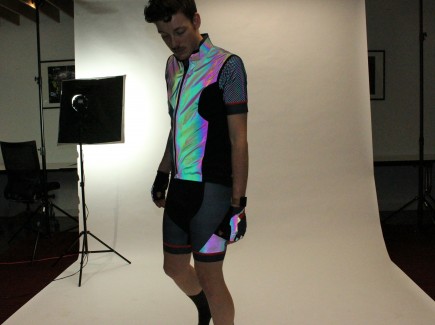
The panels at the leg and the rear are sublimated – a process which allows multiple colours on the same panel by printing onto white lycra. Whilst this has the benefit of allowing greater creative freedom to the design-team, it’s not always the best choice functionally. When stretched, sublimated panels reveal the white beneath, and over time are more likely to become see-through. For this reason, most bib-shorts on the market are made of a single colour. Wisely, NSR have left the most crucial panels black, which will help preserve modesty long-term.
Reflective elements from the same material as the gilet are at the base/side of the leg, and are usefully placed for visibility, moving up and down with the legs to enhance visibility.
Flash Spectrum Gloves
Price: ~$35AUD
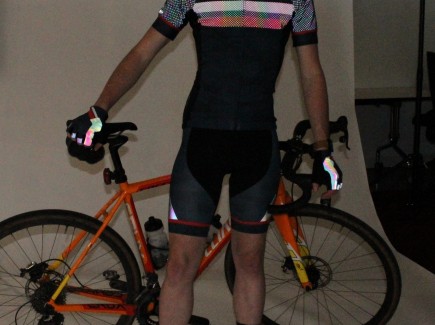
Gloves are a really handy place for reflective elements, aiding with signalling in dark and gloomy conditions. NSR’s version features well-proportioned reflective elements on the top of the hand, paired with a gel-padded synthetic palm. All these components in isolation work well, but I found the elasticated wrist closure a bit tight to be truly comfortable. I prefer a lower-cut wrist, and found the internal stitching at the webbing of the fingers a little rough.
Conclusion
NSR have made an audacious play for the high-end cycling market, and have commendably introduced a rare degree of reflective elements into their Flash collection.
The range shows significant promise and demonstrates the manufacturer’s aptitude with many different fabrics. However, some sizing irregularities make it far from certain that a mail-order consumer will end up with a correctly-fitting garment. Beyond that, we also encountered some issues with cut and patterning.
The visibility of the kit is a solid selling-point, and makes it stand out both literally and in the market. However, when compared to the limited range of other reflective gear out there (from Capo, ProViz, Sugoi, etc.), NSR’s version is slightly less impressive in function.
In price, NSR competes against established European brands and not all that far off from the offerings of heavy-hitters like Rapha and Assos. In Australia, that’s a really tough market to crack as a new brand, particularly given the competition has runs on the board with consumers and a well-honed product. NSR’s offerings are promising but imperfect, and reveal just how challenging cycling clothing is to get right – even with manufacturing clout to back it up. There’s enough there for us to be curious about the brand’s future potential, however, and we look forward to seeing their continued growth.
For more or to buy, visit nsrriding.com. Pricing varies with rises and falls in exchange rates – all prices above are approximate.

